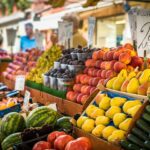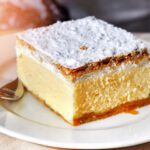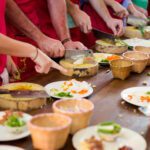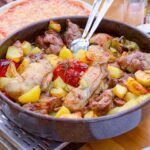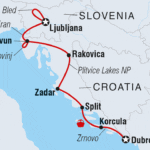Slovenia & Croatia Real Food Adventure
Embark on an 11-day food inspired journey through Slovenia and Croatia and delight in the culinary mastery of this region, while seeing the history, culture and nature these countries have to offer. Visit salt pans, a truffle farm, wineries, fishing villages and so much more. Discover why Istria is considered one of the world's leading producers of quality olive oil, eat slow-cooked meat cooked Dalmatian-style under a metal bell, raise a glass of refosk (Slovenian wine) or slivovitz (plum brandy) with your small group, and shout ‘zivjeli!’ to the simple, home-style cuisine this region is famous for.
11 days, from
$4,600
per person
GROUP SIZE
ACTIVITY LEVEL
Details
Countries Visited:
Croatia
Slovenia
Accommodation: Hotel (4 nights), Apartment (5 nights), Guesthouse (1 night)
Transportation: Private Vehicle , Public Bus , Ferry , Taxi
Included Meals:
- 6 breakfasts
- 3 lunches
- 2 dinners
Group size: Minimum 1, Max 12
Minimum Age: 15
Tuck into a traditional home-cooked dinner in Rakovica – enjoy a hearty serving of traditional Croatian kotlovina which is a mixed meat dish, traditionally made in a cauldron with robust flavours and hints of spice.
Learn how to prepare local delicacies with hands-on experiences that include taking a cooking class in Ljubljana to indulge in Slovenian favourites, and learning how to make local hand-rolled pasta in a small village on Korcula.
Get to know the local producers of some of the best eats in southern Europe with a tasting tour and lunch at a family-owned restaurant in Piran and a special truffle hunting experience with an expert in Livade. Plus, meet a Pag Island cheese maker and take a tour of Old Town Split with a local foodie.
Explore the major food reg cions of Istria and Dalmatia to indulge in iconic delicacies like cured meats, olive oils, wine, truffles, cheese and more.
Discover the fairytale landscapes of Lake Bled, walk the boardwalks and wonder at the falls of Plitvice Lakes, experience the sparkling port-side city of Split and visit the lush Croatian island of Korcula – surrounded by the sparkling Adriatic.
Itinerary
Zivjo! Welcome to Slovenia. Known as ‘Europe in Miniature’, tiny Slovenia has a huge heart and a wealth of diversity. Best known for hearty, alpine stews, goulash and sauerkraut, Slovenia also boasts wonderful cakes and strudels, not to mention the culinary treasures found in the coastal Karst region, including teran (wine), prsut (air-dried ham) and sensational olive oils. Picturesque Ljubljana is perfect for starting a food odyssey, with a surprisingly diverse food scene – great local eateries, progressive modern restaurants, street food, cafes and cake shops. Your adventure officially kicks off with an important welcome meeting at 6 pm. After this, perhaps toast to your trip with a glass of Slovenia's national drink: schnapps (zganje in Slovene). This fruit-based liqueur comes in a variety of flavours, with the local favourite being viljamoka – flavoured with Williams pear. Your leader can then suggest a great place in the heart of the city to sample some delicious traditional dishes.
This morning, take a public bus to the city of Bled, on stunning Lake Bled at the edge of the Julian Alps. You will have a large part of the day here but be sure to taste one thing in particular – a delicious cream cake called kremna rezina (kremsnita to the locals). It’s thought to have been invented in the kitchens of Hotel Park in 1953 by Istvan Lukacevic – chef of the hotel's confectionery store. Since its invention, more than ten million kremsnita have been baked at the hotel's patisserie. Tuck into your own slice to find out what all the fuss is about. Afterwards, perhaps hike up to Bled Castle or visit the 17th century baroque Church of the Assumption, or simply take a stroll around the lake. Return to Ljubljana in the early afternoon. In the evening, head over to a Slovenian culinary workshop in the evening to pick up some tips for creating some traditional Slovenian fare at home, followed by a hearty meal. Your hosts will provide a tasting of typical Slovenian cold starters so you won't get hungry as you cook!
This morning, travel by public bus to Piran – a coastal town, located near the border of Italy and Croatia. The region is renowned for its production of quality olive oils, wine (especially the distinctive teran and refosk), as well as a cured ham called prsut. This is air-dried in the cold dry wind (known as the bura), which sweeps down to the coast. Take a tasting tour of the township, then venture into a family-owned konoba (restaurant) for lunch and a wine tasting. Everything you eat is grown and prepared on the property. Next, head to the nearby salt pans of Piran where salt is still manually harvested with traditional tools according to a seven centuries' old process. Cross the border into Croatia. Croatia has long piqued the interest of curious travellers searching for sunshine, sand and scenery, with charming cobblestone towns and World Heritage sites. More recently, it’s gained recognition as an exciting food and wine destination, with the region of Istria leading the charge as the culinary capital of the country. Arrive at your final destination, the Istrian town of Motovun, by early evening where you’ll be free to create your own food adventures.
Motovun is one of the best-preserved medieval Istrian towns in Croatia, with houses scattered all over the hill and a spectacular view of Mirna River Valley. Motovun Forest is the best place for hunting the famous Istrian truffle, and the nearby village of Livade is considered the truffle capital of Istria. Take a walk through the woods with an experienced truffle hunter and learn about this intriguing vocation. Perhaps even sniff out a truffle of your own! Then enjoy a tasting of regional specialties including olives, honey and (of course) truffles. Arrive to the romantic Croatian town of Rovinj, one of the best-kept towns on the Adriatic Coast where you’ll enjoy an orientation walk through the old town. Among Rovinj's qualities is the beautiful, architecturally intact old town centre, with a relaxed Mediterranean feel. Through the centuries, Rovinj’s character has enchanted many an artist or writer, including Jules Verne. Return to Motovun and spend the evening at your leisure, perhaps seek out a local restaurant to taste more of the fantastic local produce.
Take a private transfer to the stunning World Heritage-listed Plitvice Lakes National Park – the largest national park in Croatia and known to be one of the oldest in southeast Europe, full of waterfalls and spectral blue lakes. The waters tumble from a high, tree-lined ridge down through the valley before skirting dense forests of beech, spruce and pine. The Upper Lakes are in the dolomite cliffs, where rushing water weaves in and out of the karst before dropping dramatically down to the forest, grottoes and steep cliffs of the Lower Lakes. Take in this lush environment on a walk and boat trip through the park. Head onwards to Rakovica village where you’ll stay the night. Dinner includes a delicious home cooked meal provided by your hosts – a hearty serving of traditional Croatian kotlovina. This mixed meat dish consists mainly of pork schnitzels and sausages, traditionally made in a cauldron (which translates to kotlovina) for large groups of people, feasts, holiday celebrations or just parties. The hosts will let you witness firsthand how the meal is prepared before you tuck in, enjoying the robust flavours and hints of spice.
Farewell your hosts after breakfast and then travel by bus to nearby Pag Island. The karst island of Pag is home to sheep and a determined group of islanders who wring themselves a living from the barren, rocky landscape. Settled in pre-Roman times, the island has been at the mercy of the shifting fortunes of various Dalmatian rulers, and today, reminders of its prosperous salt-mining past lie in the main town. Meet a producer of the island's renowned cheese: paski sir. This artisan sheep's milk cheese has long been a valued commodity of the island. Discover more about the production process and enjoy a tasting. There will also be an option to enjoy a specialty dish of the region – lamb cooked peka-style – beneath a metal bell. With a fully belly, continue on to the walled city of Zadar. For centuries, Zadar was the capital city of Dalmatia, and the city's rich heritage is visible at every step. It’s also celebrated for many culinary treasures, including fresh seafood, the sheep and goats that are reared for their meat and milk in the mountains to the north, and the wonderful fresh produce that is grown in a broad belt of land surrounding Zadar. Don't forget to try the famous liqueur, Maraskino, made from locally grown maraschino cherries according to a centuries' old secret recipe. This unique drink was a favourite at European imperial and royal courts and has been produced in Zadar since 1821.
Rise early this morning for a stroll through Zadar's vibrant fish market. The fish market is built into the city ramparts at the exact spot where the trawlers land with their catch. You’ll also get an opportunity to see some of the produce grown in the area this morning. Depending on the season, you may find citrus fruits and kiwis from the islands, fresh and dried figs and home-made olive oil. Afterwards, travel by public bus southeast to Split, arriving in the late afternoon. Take in vistas over vineyards, olive groves, bays, beaches, steep cliffs and islands along the way. The evening is free for your own food adventures – your leader will have plenty of local suggestions.
You may like to live like a local this morning, strolling out to find breakfast at a local cafe, sipping coffee and watching the city come to life. If you're not a breakfast person, enjoy a lie in before discovering the vibrant mixture of golden history and present-day delights in the city of Split which grew out from the remains of Diocletian's Palace. After you’ve admired some of the most impressive ruins on the Mediterranean, soak up the sights and flavours of the city on a walking tour with a local foodie. Wander the district's winding streets before heading into the market to learn about Croatian agriculture and cuisine. Taste produce like local fruit, veggies, dried orange peel (a typical snack in Split) and finish with a lunch of soparnik, a traditional bakery treat made from finely ground wheat flour. The rest of the day is free for you to explore. Perhaps take in the fantastically preserved basements under the city, along with the Cathedral in Docletian’s Peristyle and Jupiter’s Temple. As the evening rolls in, you may choose to take another cooking class or put your feet up and relax over a hearty Croatian meal.
Enjoy a free morning in Split before catching a ferry to Korcula. Upon arrival, embark on an orientation walk to get a feel for this historic fortified island town. Korcula is steeped in a long history and has been home to Greek, Slav and Roman settlers – resulting in a romantic and evocative cultural old town. What's more, there are plenty of warm beaches to relax on if that's more your speed. You might like to take a swim, walk around the bays and villages near Korcula town, pay a visit to the Marco Polo Tower, go shopping, or just soak up the ambience. Later in the evening, you will have the option to make the short journey by local bus (approximately 30 minutes) to the tiny village of Pupnat in the interior of the island. Consider dinner in the village, enjoying a meal made entirely from local produce. Perhaps even try drinking your wine like the locals do – mixed with a bit of water.
Relax into island life in the morning before heading to Zrnovo village for a hands-on cooking class. You’ll learn how to make zrnovo makaruni (a local hand-rolled pasta), which you’ll enjoy with lunch and some included local wines. One of these wines is Grk – a curious drop. The wine cannot replicate itself as it only has female parts and needs to be planted with another male grape variety in order to pollinate. It seems like a lot of work to make a wine, but the end result is a glass of acidic white, featuring a robust aroma and hints of pine that has been loved around the country for ages. In the afternoon, return to Korcula town for some free time – beach, anyone?
Travel to Dubrovnik by catamaran this morning. With the sparkling water of the Adriatic in the background, Dubrovnik is picturesque, full of character and can easily be covered on foot. With no activities planned, once we arrive in Dubrovnik your tour will come to an end. Your catamaran will arrive conveniently near the central bus station, from which you can get connections to the airport. If you would like to spend more time in Dubrovnik (which we highly recommend), we’ll be happy to book additional accommodation for you (subject to availability). You group leader will be able to point you in the right direction to your accommodation or onward journey.


